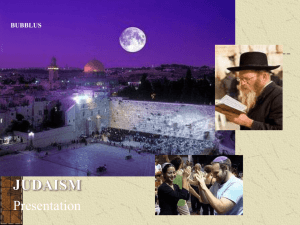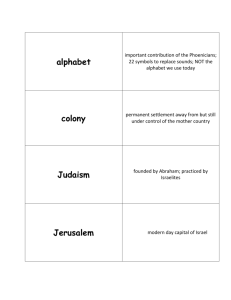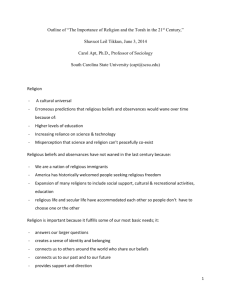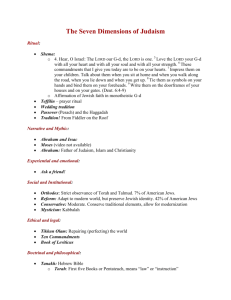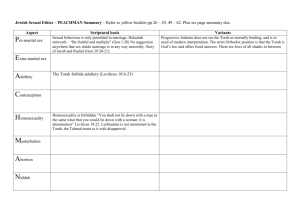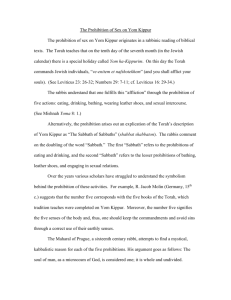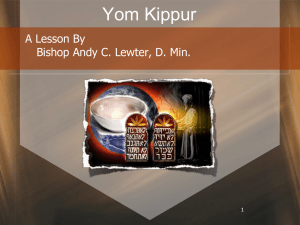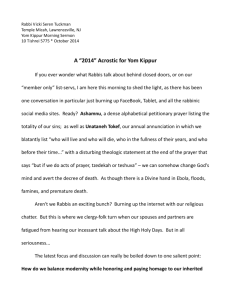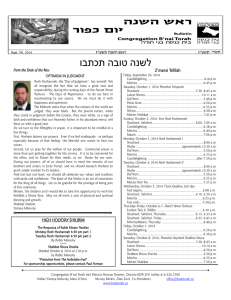Jewish High Holy Days
advertisement
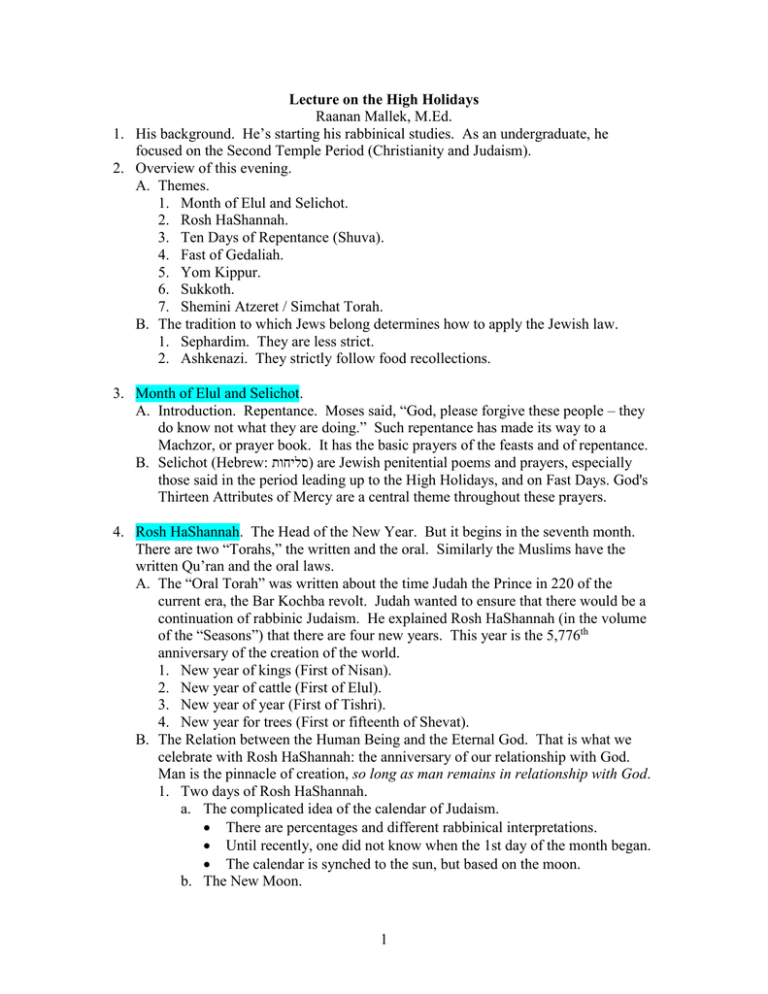
Lecture on the High Holidays Raanan Mallek, M.Ed. 1. His background. He’s starting his rabbinical studies. As an undergraduate, he focused on the Second Temple Period (Christianity and Judaism). 2. Overview of this evening. A. Themes. 1. Month of Elul and Selichot. 2. Rosh HaShannah. 3. Ten Days of Repentance (Shuva). 4. Fast of Gedaliah. 5. Yom Kippur. 6. Sukkoth. 7. Shemini Atzeret / Simchat Torah. B. The tradition to which Jews belong determines how to apply the Jewish law. 1. Sephardim. They are less strict. 2. Ashkenazi. They strictly follow food recollections. 3. Month of Elul and Selichot. A. Introduction. Repentance. Moses said, “God, please forgive these people – they do know not what they are doing.” Such repentance has made its way to a Machzor, or prayer book. It has the basic prayers of the feasts and of repentance. B. Selichot (Hebrew: )תוחילסare Jewish penitential poems and prayers, especially those said in the period leading up to the High Holidays, and on Fast Days. God's Thirteen Attributes of Mercy are a central theme throughout these prayers. 4. Rosh HaShannah. The Head of the New Year. But it begins in the seventh month. There are two “Torahs,” the written and the oral. Similarly the Muslims have the written Qu’ran and the oral laws. A. The “Oral Torah” was written about the time Judah the Prince in 220 of the current era, the Bar Kochba revolt. Judah wanted to ensure that there would be a continuation of rabbinic Judaism. He explained Rosh HaShannah (in the volume of the “Seasons”) that there are four new years. This year is the 5,776th anniversary of the creation of the world. 1. New year of kings (First of Nisan). 2. New year of cattle (First of Elul). 3. New year of year (First of Tishri). 4. New year for trees (First or fifteenth of Shevat). B. The Relation between the Human Being and the Eternal God. That is what we celebrate with Rosh HaShannah: the anniversary of our relationship with God. Man is the pinnacle of creation, so long as man remains in relationship with God. 1. Two days of Rosh HaShannah. a. The complicated idea of the calendar of Judaism. There are percentages and different rabbinical interpretations. Until recently, one did not know when the 1st day of the month began. The calendar is synched to the sun, but based on the moon. b. The New Moon. 1 2. The Shofar (or trumpet). a. It was created by the Nazirite rabbi (or Jewish monk), to whom Ranaan has a relationship. b. Abraham was to sacrifice Isaac, but the ram was caught in the thicket. Jacob is the progenitor of Judaism, Esau the progenitor of Christianity. c. Three types of blowing. Tekiah (one large blast). Shevarim (three short blasts). Teruah (nine short blasts). d. The Saduccees wanted the shofar only blown at the temple, but a famous rabbi rejected this. Read about it in Josephus Flavius (on the Pharisees). 3. Special Foods. a. The round Halah or bread. It signifies the circularity of the calendar. It is dipped into honey instead of salt. b. New Years Resolutions. Jews will make resolutions and cast bread into the water, so fish will eat them. The fish are the saddiqim or righteous. c. The liturgy is not in Hebrew but in Aramaic. 5. Ten Days of Repentance. A. Judgment. God judges, but humans can appeal. B. This appeal takes place during the “ten days of repentance.” They begin with Rosh HaShannah and ends with Yom Kippur. This is the time dedicated to serious Techuva (or repentance). 6. The Fast of Gedaliah. A. It has its roots in 581, right after the return of the Exiles. Gedaliah was the governor of Judea from 586-581 BC. B. Gedaliah was killed (Yitzak Rabin was seen as a collaborator, just as Gedaliah was seen as a collaborator with Babylon). C. Gedaliah’s murderer was Ishmael ben Netaniah, a desendent of the royal family (2 Kg. 25:25-26 and Jer. 41). He was sent by Baalis, King of Ammon. 7. Yom Kippur, the Day of Atonment. D. It is the penultimate Sabbath, because on this day Jews appeal and win their appeal to God through their prayers and fasting and ascesis. 1. Definition. As a purification ritual, Jews observe hours of fast and certain activities are abstained from. It last one day and night. There are five services. o Kol Nidre, the prayer to annul all vows. o The Shema. The prayer of Moses that he received from angels. o Avinu Malkinu, the prayer during a time of fasting. o Viduy. The prayer to confess one’s sins. o Neilah. The closing prayer of Yom Kippur. There are ten days of repentance. Leviticus 27 tells the story of Yom Kippur. 2 2. Heart of Judaism. It is consider the highest holiday of the year for the Jewish people. It includes a 25 hour fast. E. The Wilderness is essential to Judaism. God took the people out of Egypt to the wilderness so that they might hear the Word, dabar. 8. Sukkoth. A. Definition. The Sukkoth is the Jewish thanksgiving. It is the feast of booths or Tabernacles. It is a celebration of the harvest and autumnal season. 1. Sukkoth takes place on seven days and nights. 2. It takes place on the 15th of the month of Tishrei. 3. There are four species (palm, willow, myrtle, and etrog). 4. Origin. We can read about it in Leviticus 40. B. Sukkot celebrates harvest and autumn. One builds a sukkah or booth to recall what it was like to live in the desert. 9. Shemini Atzeret / Simchat Torah. A. The “Eighth Day” completes the “Seven Days” of Sukkoth. B. This celebration marks the conclusion of the annual cycle of public torah readings, and the beginning of a new cycle. C. Simchat torah. "Rejoicing of/[with the]Torah") is a Jewish holiday that celebrates and marks the conclusion of the annual cycle of public Torah readings, and the beginning of a new cycle. 3
